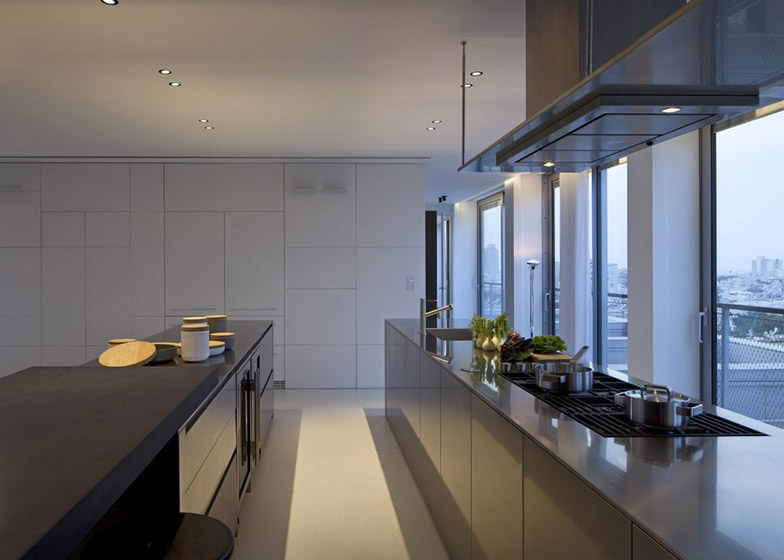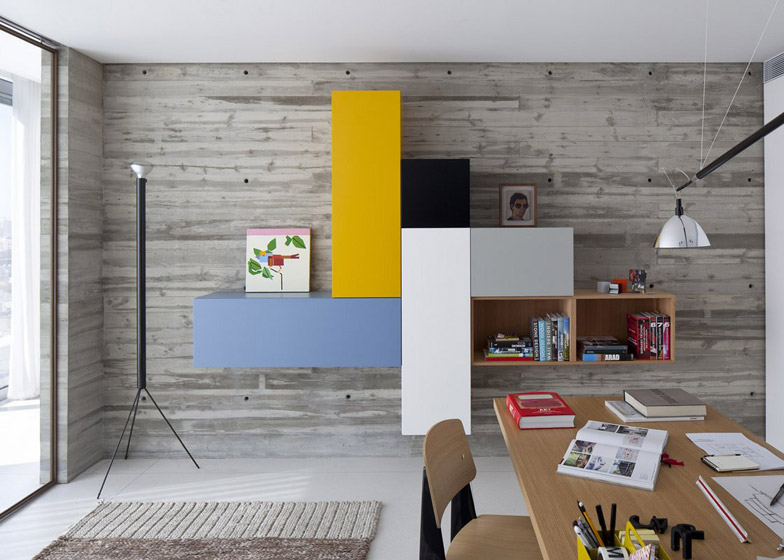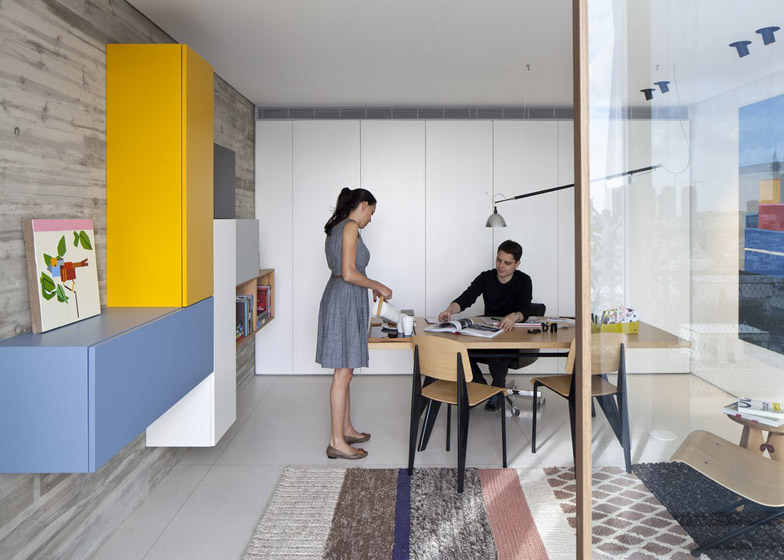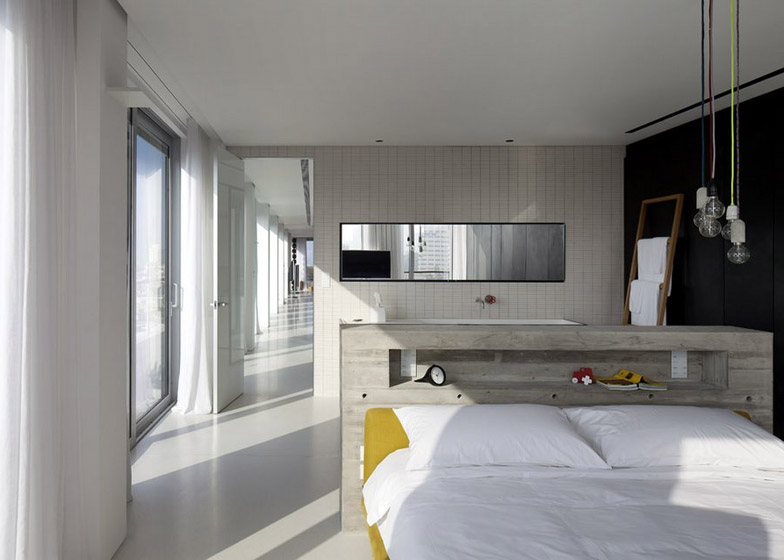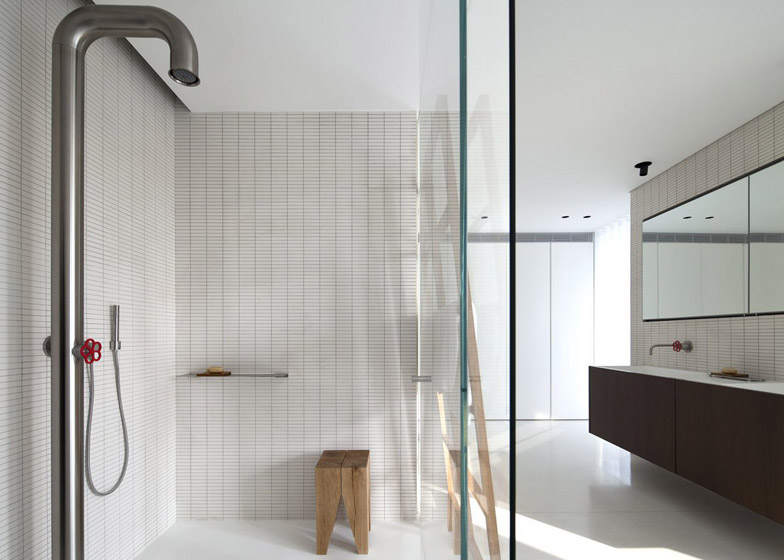A rooftop swimming pool runs along the edge of this renovated penthouse in Tel Aviv by Israeli architect Pitsou Kedem, allowing residents to look down over the old town rooftops while enjoying a swim. (+ slideshow).
Pitsou Kedem – whose past projects include an apartment renovation with vaulted ceilings and a house with a sliding glass facade – renovated the top floor of an apartment block in the north of Tel Aviv to create the Antokolsky Penthouse, creating an open-plan living space that makes the most of the view.
As part of the brief, the architect created a balcony that spans the length of the penthouse, then added an infinity pool that appears to line up with the city skyline.
"The pool is completely covered with dark stone so that the city can be reflected in its entirety in the water," Kedem told Dezeen.
Frangipani trees border the balcony, designed to mirror the flora often found in traditional Tel Aviv gardens, while an external dining area shaded by a slatted roof offers space for socialising.
Twenty five metre-long glazed screens with light teak frames surround the apartment on every side, offering 360 degree views.
"The internal spaces, floating within the building's shell, are fully exposed to the city, thus long and continuous lines of sight are preserved from one end of the apartment to the other," Kedem explained.
When the weather is good, a glazed door slides open to connect the terrace with the living room, which features a dark metal bookcase set against a raw concrete wall.
The dining area is furnished with metal table and low chairs. Free standing kitchen islands with granite worktops sit at the other end of the space, reflecting the terrazzo floor in a series of metallic panels.
A glazed corridor runs along one side of the penthouse, providing views of the horizon and allowing natural light to spread throughout the space. A bathroom at one end of the corridor features an exposed concrete wall and stark white design.
At the other end, the architect designed an office with a wall-mounted storage unit comprised of colourful blocks, stacked together to store and display the client's possessions. Artwork rests on the geometric unit and hangs on the opposite wall, injecting colour into the study.
"The apartment's residents have an impressive collection of art. This played a significant role in the design of the spaces, each of which relates to the specific piece displayed in it," Kedem said.
A glass passage on the other side of the living space leads to the combined master suite and bathroom, separated by a low concrete wall with a beside alcove set into it.
Bulbs with multicoloured wires hang over the bedroom, which leads onto the balcony, while ceramic tiles line the interior of an en suite bathroom with a timber-clad bathtub and wash basin.
The main bathroom features a similar design, with taps picked out in red and a pine towel rack that acts as a window frame, leaning against the glass wall of the shower.
Photography is by Amit Garon.
Here's some more text from Pitsou Kedem:
Antokolsky Penthouse, Tel Aviv, Israel
This unconventional design by Pitsou Kedem blurs the borders between private space and outdoor space. In a new building, in the old north of Tel Aviv, a unique penthouse covering an entire floor of some 600 square meters, is open and transparent in four directions.
The entire penthouse is wrapped with a screen of clear walls. The internal spaces, floating within the building's shell, are fully exposed to the city. Passages and movement, or corridors in conventional design language, to the rooms and then, on to the apartment's spaces are next to the structure's outer shell.
No rooms connect with this outer shell and no rooms block or shut off the view over the city. The levels of transparency and exposure are regulated using various methods of shading. Thus long and continuous lines of sight are preserved from one of the apartment to the other.
Along the entire frontage, some 25 meters, there are transparent, teak framed, sliding doors which allow for the opening and closing of the various internal spaces, such as bedrooms and bathrooms, to the external shell. Thus the city merges into the apartment, the climate is regulated and the residents can enjoy the sky line and changing lights at any given time.
The apartment's style corresponds with international styling whilst retaining classical influences in the spirit of the period. Such as, for example, the style of French architect Jean Prouvé whose work was unembellished, placing the emphasis on practicality.
The materials used in the apartment's construction are, for the most part, shown in their raw state. The floor is poured terrazzo and an exposed concrete wall in the living room is offset with a metal bookcase. The pool is completely covered with dark stone so that the city can be reflected in its entirety in the water.
Along the balcony we find planters with Frangipani trees that reflect and continue the characteristic flora of many Tel Aviv gardens.
The apartment's residents have an impressive collection of art. This played a significant role in the design of the spaces, each of which relates to the specific piece displayed in it.
And the responsibility for bringing a smile to the design has been given the yellow hue that has been used in the main door, the closet and additional touches of yellow scattered around the apartment.
Design: Pitsou Kedem Architects
Head architect: Ran M. Broides
Design Team: Pitsou Kedem, Ran M. Broides, Nurit Ben Yosef and Irene Goldberg
Styling for photographs: Eti Buskila







